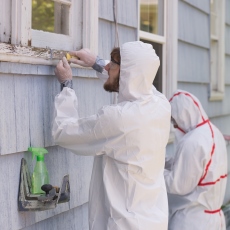Summary 
Lead is a metal that occurs naturally in the earth's crust. Lead can be found in all parts of our environment. Much of it comes from human activities such as mining and manufacturing. Lead used to be in paint; older houses may still have lead paint. You could be exposed to lead by:
- Eating food or drinking water that contains lead. Water pipes in older homes may contain lead.
- Working in a job where lead is used
- Using lead in a hobby, such as making stained glass or lead-glazed pottery
- Using folk remedies such as herbs or foods that contain lead
Breathing air, drinking water, eating food, or swallowing or touching dirt that contains lead can cause many health problems. Lead can affect almost every organ and system in your body. In adults, lead can increase blood pressure and cause infertility, nerve disorders, and muscle and joint pain. It can also make you irritable and affect your ability to concentrate and remember.
Lead is especially dangerous for children. A child who swallows large amounts of lead may develop anemia, severe stomachache, muscle weakness, and brain damage. Even at low levels, lead can affect a child's mental and physical growth.
Agency for Toxic Substances Disease Registry
Start Here
- Lead (Centers for Disease Control and Prevention)
- Lead (Environmental Protection Agency)
- Learn about Lead (Environmental Protection Agency)
Diagnosis and Tests
- Blood Test: Lead (For Parents) (Nemours Foundation)Also in Spanish
- Heavy Metal Blood Test
 (National Library of Medicine)Also in Spanish
(National Library of Medicine)Also in Spanish
Prevention and Risk Factors
- Lead Poisoning Prevention Tips (Centers for Disease Control and Prevention)
- Protect Your Family from Sources of Lead (Environmental Protection Agency)
- Renovate Right: Important Lead Hazard Information for Families, Child Care Providers, and Schools (Environmental Protection Agency) - PDF
Related Issues
- Candy (Centers for Disease Control and Prevention)
- Folk Medicine (Centers for Disease Control and Prevention)
- Lead and Drinking Water from Private Wells (Centers for Disease Control and Prevention)
- Lead in Drinking Water (Centers for Disease Control and Prevention)
- Safety and Health Topics: Lead (Occupational Safety and Health Administration)
- Water (Centers for Disease Control and Prevention)
Specifics
- Basic Information about Lead in Drinking Water (Environmental Protection Agency)
- Kohl, Kajal, Al-Kahl, or Surma: By Any Name, Beware of Lead Poisoning (Food and Drug Administration)
- Lead (Pb) Air Pollution (Environmental Protection Agency)
Clinical Trials
- ClinicalTrials.gov: Lead Poisoning
 (National Institutes of Health)
(National Institutes of Health)
Journal Articles, References and abstracts from MEDLINE/PubMed (National Library of Medicine)
Find an Expert
- Centers for Disease Control and Prevention Also in Spanish
- Environmental Protection Agency Also in Spanish
- National Center for Environmental Health (Centers for Disease Control and Prevention)
- National Institute of Environmental Health Sciences
 Also in Spanish
Also in Spanish
Children
- Lead Poisoning
 (National Institute of Environmental Health Sciences)
(National Institute of Environmental Health Sciences)
Patient Handouts
- Lead - nutritional considerations (Medical Encyclopedia)Also in Spanish
- Lead levels - blood (Medical Encyclopedia)Also in Spanish
- Lead poisoning (Medical Encyclopedia)Also in Spanish
- Lead Toxicity (Agency for Toxic Substances and Disease Registry) - PDF
